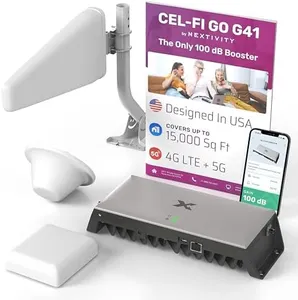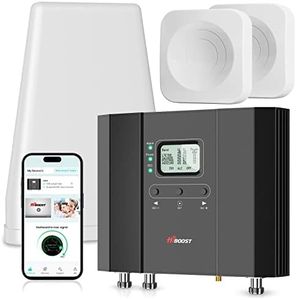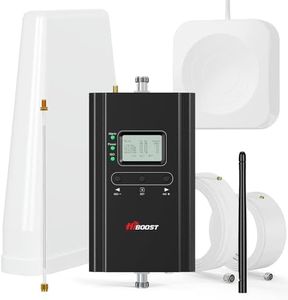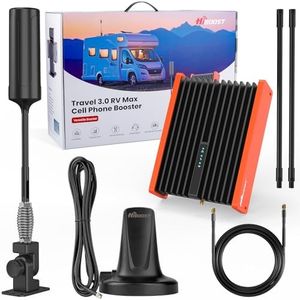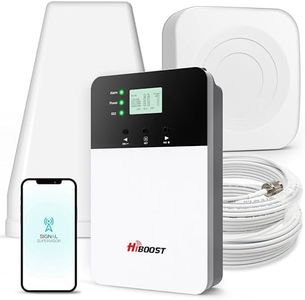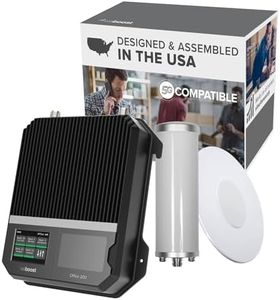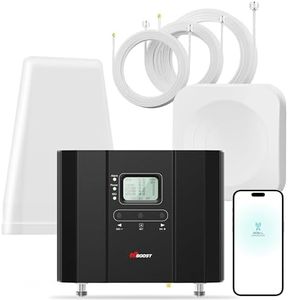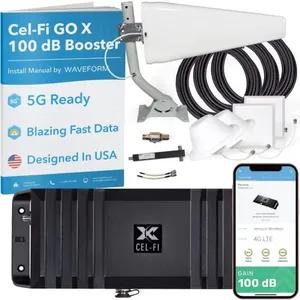10 Best Home Cell Signal Boosters 2025 in the United States
Our technology thoroughly searches through the online shopping world, reviewing hundreds of sites. We then process and analyze this information, updating in real-time to bring you the latest top-rated products. This way, you always get the best and most current options available.

Our Top Picks
Winner
weBoost Home Complete | Powerful Multi-Carrier Cell Phone Signal Booster for 5G & 4G LTE | Simultaneous support for all U.S. Carriers - Verizon, AT&T, T-Mobile & more (model# 470145), DIY
Most important from
3225 reviews
The weBoost Home Complete is designed to improve cell signal across an entire home, covering up to 7,500 square feet, which makes it a strong option for large houses or rural areas where signal tends to be weak. It works with all major U.S. carriers like Verizon, AT&T, and T-Mobile, so you won’t need separate devices or plans for different phones in your household. The booster supports both 4G LTE and 5G, future-proofing your setup as networks evolve. With an FCC-approved gain of up to 100 times signal strength, it can significantly reduce dropped calls, buffering, and slow data speeds, helping you stay connected whether streaming, working, or chatting.
Installation is designed to be DIY-friendly, including a panel antenna for inside and a directional antenna for outside, with mounting brackets to suit different setups. This means you can set it up yourself without professional help, though some users might find positioning the antennas a bit tricky to get the best signal. The included weBoost app is a handy feature that helps you find nearby cell towers and check signal strength before and after installation, making the setup process smoother. On the downside, while it covers a large area well, homes larger than 7,500 square feet might need an additional unit or different solution. The product weighs about 1.5 pounds and has moderate dimensions, so space is needed for installation.
Some users have noted that signal improvement depends on having at least some existing outside signal, so it might not work in very remote spots with no reception at all. This model is well-suited for most homeowners wanting a reliable, multi-carrier booster with wide coverage and simple installation, especially if you value improved call quality and faster data across your entire home.
Most important from
3225 reviews
CEL-FI GO G41 | Cell Phone Booster for Home | 4G, 5G, AT&T, Verizon & T-Mobile | Up to 15,000 Sq Ft Coverage | 100 dB Cell Phone Signal Booster | FCC Approved | 1 Antenna Kit
Most important from
708 reviews
The CEL-FI GO G41 is a strong choice for improving cell signal in a home, offering impressive coverage up to 15,000 square feet, which is quite large compared to many other boosters. It supports major carriers like AT&T, Verizon, and T-Mobile, making it versatile if you switch providers or have multiple users on different networks. The booster handles important frequency bands (700 MHz and 1700/2100 MHz), covering common 4G and partial 5G signals, with a software update planned to fully support 5G soon.
A standout feature is its high signal gain of 100 dB, which means it can amplify weak signals much more effectively than many competitors. This gain level allows one device to cover a whole home, avoiding the need for multiple boosters. The unit includes two antenna types—a dome and a panel—giving flexibility in installation depending on your home layout. Installation might be a bit more involved than basic boosters because you'll need to position the external antenna where it receives the best outdoor signal and connect the booster inside. The product size and weight are moderate but manageable for most homeowners.
Being FCC certified ensures it meets safety and interference standards, which is reassuring. Customer feedback averages well with a 4.4-star rating, indicating users generally find it reliable and effective. On the downside, the booster supports a limited range of frequency bands, so if your carrier uses bands outside 700 or 1700/2100 MHz, performance might be less optimal. Also, while it is 5G ready, full 5G support depends on a future software update, so if you’re looking for immediate top-tier 5G performance, you might need to wait. The CEL-FI GO G41 is a solid solution for homeowners needing broad coverage and strong signal gain across major US carriers, especially if you want a device that can scale for larger homes and offers future-proofing for 5G.
Most important from
708 reviews
HiBoost Cell Phone Booster for Multiroom, Boost Cellular Signal up to 10,000 sq ft for All U.S. Carriers | Cell Phone Signal Boosters with 2 Inside Antennas Set for Homes & Offices 2-Story
Most important from
649 reviews
The HiBoost Cell Phone Booster is designed to improve cellular signal throughout large homes or offices, covering up to 10,000 square feet with its two indoor antennas. It offers strong signal amplification with a maximum gain of 70dB, which is among the higher gains available for home boosters. This means it can effectively strengthen weak signals in multi-room, multi-floor buildings, as long as there’s at least one bar of signal outside to begin with. It works with all major U.S. carriers, including Verizon, AT&T, T-Mobile, and Sprint, supporting both 4G LTE and 5G signals where those 5G bands overlap with existing 4G frequencies. However, it doesn’t support newer 5G mmWave bands, so if you rely on those, this might not fully meet your needs.
Installation is user-friendly thanks to a specialized app that guides setup and signal optimization, and the included cables reduce signal loss, which is essential for maintaining good performance over longer distances. The setup avoids complicated drilling by using a window wire for the outdoor antenna, making it easier for most users to install. The signal booster also has an LCD screen for real-time monitoring and offers good customer support with a three-year warranty.
Some very large homes or buildings might require multiple units or additional antennas despite the large coverage area. Also, because it only supports 5G on existing 4G bands, future-proofing might be limited if carriers shift to newer 5G frequencies. This booster is well suited for users needing to enhance cellular signals across multiple rooms or floors in medium to large homes, especially if they want straightforward installation and broad carrier compatibility without venturing into the latest 5G bands.
Most important from
649 reviews
Buying Guide for the Best Home Cell Signal Boosters
Choosing the right home cell signal booster can significantly improve your mobile phone's reception, ensuring you have a strong and reliable signal throughout your home. To make the best choice, it's important to understand the key specifications and how they relate to your specific needs. Here are the main factors to consider when selecting a home cell signal booster.FAQ
Most Popular Categories Right Now



